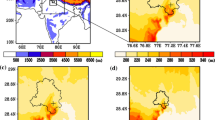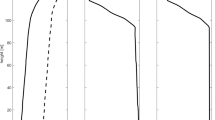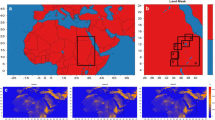Abstract
The numerical weather prediction of radiation fog is challenging, as many models typically show large biases for the timing of the onset and dispersal of the fog, as well as for its depth and liquid water content. To understand the role of physical processes, i.e. turbulence, radiation, land-surface coupling, and microphysics, we evaluate the HARMONIE and Weather Research and Forecasting (WRF) mesoscale models for two contrasting warm fog episodes at the relatively flat terrain around the Cabauw tower facility in the Netherlands. One case involves a radiation fog that arose in calm anticyclonic conditions, and the second is a radiation fog that developed just after a cold front passage. The WRF model represents the radiation fog well, while the HARMONIE model forecasts a stratus lowering fog layer in the first case and hardly any fog in the second case. Permutations of parametrization schemes for boundary-layer mixing, radiation and microphysics, each for two levels of complexity, have been evaluated within the WRF model. It appears that the boundary-layer formulation is critical for forecasting the fog onset, while for fog dispersal the choice of the microphysical scheme is a key element, where a double-moment scheme outperforms any of the single-moment schemes. Finally, the WRF model results appear to be relatively insensitive to horizontal grid spacing, but nesting deteriorates the modelled fog formation. Increasing the domain size leads to a more scattered character of the simulated fog. Model results with one-way or two-way nesting show approximately comparable results.














Similar content being viewed by others
References
Bartok J, Bott A, Gera M (2012) Fog prediction for road traffic safety in a coastal desert region. Boundary-Layer Meteorol 145:485–506
Beljaars ACM, Bosveld FC (1997) Cabauw data for the validation of land surface parametrization schemes. J Clim 10:1172–1193
Bergot T, Guedalia D (1994) Numerical forecasting of radiation fog. Part I: numerical model and sensitivity tests. Mon Weather Rev 122:1218–1230
Bergot T, Carrer D, Noilhan J, Bougeault P (2005) Improved site-specific numerical prediction of fog and low clouds: A feasibility study. Weather Forecast 20:627–646
Bergot T, Terradellas T, Cuxart J, Mira T, Liechti O, Müller M, Nielsen NW (2007) Intercomparison of single-column numerical models for the prediction of radiation fog. J Appl Meteorol Climatol 46:504–521
Bosveld F, Baas P, Steeneveld GJ, Holtslag A, Angevine W, Bazile E, de Bruijn E, Deacu D, Edwards J, Ek M, Larson V, Pleim J, Raschendorfer M, Svensson G (2014) The third GABLS intercomparison case for evaluation studies of boundary-layer models: part B: results and process understanding. Boundary-Layer Meteorol 152:157–187
Bott A, Trautmann T (2002) PAFOG—a new efficient forecast model of radiation fog and low-level stratiform clouds. Atmos Res 64:191–203
Bott A, Sievers U, Zdunkowski W (1990) A Radiation Fog Model with a detailed treatment of the interaction between radiative transfer and fog microphysics. J Atmos Sci 47:2153–2166
Brown R, Roach WT (1976) The physics of radiation fog: II-A numerical study. Q J R Meteorol Soc 102:335–354
Chen F, Dudhia J (2001) Coupling an advanced land surface-hydrology model with the Penn State-NCAR MM5 modeling system. Part I: model implementation and sensitivity. Mon Weather Rev 129:569–585
Chen F et al (2007) Description and evaluation of the characteristics of the NCAR high-resolution land data assimilation system. J Appl Meteorol Climatol 46:694–713
Cuxart J, Jiménez MA (2011) Deep radiation fog in a wide closed valley: study by numerical modeling and remote sensing. Pure Appl Geophys 169:911–926
Cuxart J, Bougeault P, Redelsberger JL (2000) A turbulence scheme allowing for mesoscale and large-eddy simulations. Q J R Meteorol Soc 126:1–30
de Rooy WC, Siebesma AP (2008) A simple parametrization for detrainment in shallow cumulus. Mon Weather Rev 136:560–576
de Rooy WC, Siebesma AP (2010) Analytical expressions for entrainment and detrainment in cumulus convection. Q J R Meteorol Soc 136:1216–1227
Dudhia J (1989) Numerical study of convection observed during the winter monsoon experiment using a mesoscale two-dimensional model. J Atmos Sci 46:3077–3107
Duynkerke PG (1991) Radiation fog: a comparison of model simulation with detailed observations. Mon Weather Rev 119:324–341
Duynkerke PG (1999) Turbulence, radiation and fog in Dutch stable boundary layers. Boundary-Layer Meteorol 90:447–477
Edwards JM (2009) Radiative processes in the stable boundary layer: part I. Radiative aspects. Boundary-Layer Meteorol 131:105–126
Foken T (2008) The energy balance closure problem: an overview. Ecol Appl 18:1351–1367
Fu G, Guo J, Xie SP, Duan Y, Zhang M (2006) Analysis and high-resolution modeling of a dense fog event over the Yellow Sea. Atmos Res 81:293–303
Fu G, Li P, Crompton JG, Guo J, Gao S, Zhang S (2010) An observational and modeling study of a sea fog event over the Yellow Sea on 1 August 2003. Meteorol Atmos Phys 107:149–159
Gultepe I, Tardif R, Michaelides SC, Cermak J, Bott A, Bendix J, Muller M, Pagowski M, Hansen B, Ellrod G, Jacobs W, Toth G, Cober SG (2007) Fog research: a review of past achievements and future perspectives. Pure Appl Geophys 164:1121–1159
Ha KJ, Mahrt L (2003) Radiative and turbulent fluxes in the nocturnal boundary layer. Tellus 55A:317–327
Holtslag AAM, Svensson G, Baas P, Basu S, Beare B, Beljaars ACM, Bosveld FC, Cuxart J, Lindvall J, Steeneveld GJ, Tjernström M (2013) Stable atmospheric boundary layers and diurnal cycles—challenges for weather and climate models. Bull Am Meteorol Soc 94:1691–1706
Kleczek MA, Steeneveld GJ, Holtslag AAM (2014) Evaluation of the weather research and forecasting mesoscale model for GABLS3: impact of boundary-layer schemes, boundary conditions and spin-up. Boundary-Layer Meteorol 152:213–243
Leduc M, Laprise R (2009) Regional climate model sensitivity to domain size. Clim Dyn 32:833–854
Leduc M, Laprise R, Moretti-Poisson M, Morin JP (2011) Sensitivity to domain size of mid-latitude summer simulations with a regional climate model. Clim Dyn 37:343–356
Le Moigne P (2012) Surfex scientific documentation, 237 pp. http://www.cnrm.meteo.fr/surfex/IMG/pdf/surfex_scidoc_v2.pdf
Masson V, Champeaux JL, Chauvin F, Meriguet C, Lacaze R (2003) A global database of land surface parameters at 1-km resolution in meteorological and climate models. J Clim 16:1261–1282
Mlawer EJ, Taubman SJ, Brown PD, Iacono MJ, Clough SA (1997) Radiative transfer for inhomogeneous atmospheres: RRTM, a validated correlated-k model for the longwave. J Geophys Res 102:16663–16682
Müller MD, Masbou M, Bott A (2010) Three-dimensional fog forecasting in complex terrain. Q J R Meteorol Soc 136:2189–2202
Nakanishi M, Niino H (2006) An improved Mellor–Yamada level-3 model: its numerical stability and application to a regional prediction of advection fog. Boundary-Layer Meteorol 119:397–407
Pinty JP, Jabouille P (1998) A mixed-phase cloud parametrization for use in mesoscale nonhydrostatic model: simulations of a squall line and of orographic precipitations. Preprints Conference on cloud physics. American Meteorological Society, Everett, pp 217–220
Rémy S, Bergot T (2009) Assesing the impact of observations on a local numerical fog prediction system. Q J R Meteorol Soc 135:1248–1265
Román-Cascón C, Yagüe C, Sastre M, Maqueda M, Salamanca F, Viana S (2012) Observations and WRF simulations of fog events at the Spanish Northern Plateau. Adv Sci Res 8:11–18
Savijärvi H (2006) Radiative and turbulent heating rates in the clear-air boundary layer. Q J R Meteorol Soc 132:147–161
Siebesma AP, Soares PMM, Teixeira J (2007) A combined Eddy Diffusivity Mass Flux approach for the convective boundary layer. J Atmos Sci 64:1230–1248
Skamarock WC, Klemp JB, Dudhia J, Gill DO, Barker DM, Duda MG, Huang XY, Wang W, Powers WG (2008) A description of the advanced research WRF, Version 3. NCAR Technical Note, Boulder
Steeneveld GJ, Wokke MJJ, Groot Zwaaftink CD, Pijlman S, Heusinkveld BG, Jacobs AFG, Holtslag AAM (2010) Observations of the radiation divergence in the surface layer and its implication for its parametrization in numerical weather prediction models. J Geophys Res 115:D06107
Steeneveld GJ, Tolk LF, Moene AF, Hartogensis OK, Peters W, Holtslag AAM (2011) Confronting the WRF and RAMS mesoscale models with innovative observations in the Netherlands—evaluating the boundary-layer heat budget. J Geophys Res 116:D23114
Stolaki S, Pytharoulis I, Karacostas T (2011) A study of fog characteristics using a coupled WRF-COBEL Model over Thessaloniki Airport, Greece. Pure Appl Geophys 169:961–981
Syed FS, Körnich H, Tjernström M (2012) On the fog variability over south Asia. Clim Dyn 39:2993–3005
Tanaka H, Honma S, Nishi M, Igarashi T, Teramoto S, Nishio F, Abe S (1998) Acid fog and hospital visits for asthma: an epidemiological study. Eur Respir J 11:1301–1306
Teixeira J (1999) Simulation of fog with the ECMWF prognostic cloud scheme. Q J R Meteorol Soc 125:529–552
Thoma C, Schneider W, Masbou M, Bott A (2012) Integration of local observations into the one dimensional fog model PAFOG. Pure Appl Geophys 169:881–893
Tudor M (2010) Impact of horizontal diffusion, radiation and cloudiness parametrization schemes on fog forecasting in valleys. Meteorol Atmos Phys 108:57–70
Undén P et al. (2002) HIRLAM-5 scientific documentation. HIRLAM-5 Project, SMHI, Norrkoping, Sweden, 146 pp. http://www.hirlam.org/open/publications/SciDoc_Dec2002.pdf
Van der Velde IR, Steeneveld GJ, Holtslag AAM (2010) Modeling and forecasting the onset and duration of severe radiation fog under frost conditions. Mon Weather Rev 138:4237–4253
Warner TT, Peterson RA, Treadon RE (1997) A tutorial on lateral boundary conditions as a basic and potentially serious limitation to regional numerical weather prediction. Bull Am Meteorol Soc 78:2599–2617
Wild M, Ohmura A, Gilgen H, Morcrette JJ, Slingo A (2001) Evaluation of downward longwave radiation in general circulation models. J Clim 14:3227–3239
Zhou B, Du J, Gultepe I, Dimego G (2011) Forecast of low visibility and fog from NCEP: current status and efforts. Pure Appl Geophys 169:895–909
Acknowledgments
The authors thank the Royal Netherlands Meteorological Institute for providing Dutch meteorological network data and Cabauw tower data. Reinder Ronda acknowledges financial support of Knowledge for Climate research project “IMPACT”. The contribution by G.J. Steeneveld has been sponsored by the NWO contract 863.10.010 (Lifting the fog). This work was sponsored by the National Computing Facilities (NCF project SH-060-12). Finally, we thank Leo Kroon (Wageningen University) and two anonymous reviewers for their suggestions in improving the manuscript.
Author information
Authors and Affiliations
Corresponding author
Rights and permissions
About this article
Cite this article
Steeneveld, G.J., Ronda, R.J. & Holtslag, A.A.M. The Challenge of Forecasting the Onset and Development of Radiation Fog Using Mesoscale Atmospheric Models. Boundary-Layer Meteorol 154, 265–289 (2015). https://doi.org/10.1007/s10546-014-9973-8
Received:
Accepted:
Published:
Issue Date:
DOI: https://doi.org/10.1007/s10546-014-9973-8




